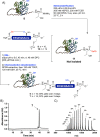Expressed Protein Selenoester Ligation
- PMID: 35194928
- PMCID: PMC9314092
- DOI: 10.1002/anie.202200163
Expressed Protein Selenoester Ligation
Abstract
Herein, we describe the development and application of a novel expressed protein selenoester ligation (EPSL) methodology for the one-pot semi-synthesis of modified proteins. EPSL harnesses the rapid kinetics of ligation reactions between modified synthetic selenopeptides and protein aryl selenoesters (generated from expressed intein fusion precursors) followed by in situ chemoselective deselenization to afford target proteins at concentrations that preclude the use of traditional ligation methods. The utility of the EPSL technology is showcased through the efficient semi-synthesis of ubiquitinated polypeptides, lipidated analogues of the membrane-associated GTPase YPT6, and site-specifically phosphorylated variants of the oligomeric chaperone protein Hsp27 at high dilution.
Keywords: Expressed Protein Selenoesters; Peptides; Protein Modifications; Protein Semi-Synthesis; Proteins.
© 2022 The Authors. Angewandte Chemie International Edition published by Wiley-VCH GmbH.
Conflict of interest statement
The authors declare no conflicts of interest.
Figures




References
Publication types
MeSH terms
Substances
LinkOut - more resources
Full Text Sources
Research Materials
Miscellaneous

